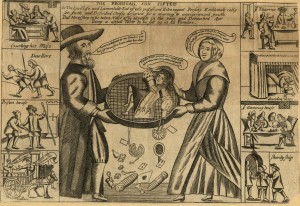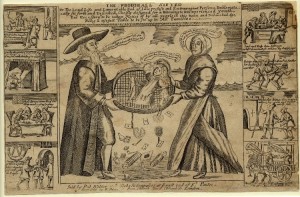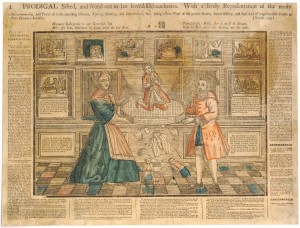Despite their various nationalities and the different periods in which they lived, the authors of the satirical prints collected by Douce seemed to share their belief that ‘things ain’t what they used to be’. When seen together, however, the prints themselves suggest that the opposite is true.
Recurrent themes include images of young men being sieved, ground, or distilled, although the purposes and results of such operations vary. The educational applications of sieving, for instance, are explored in the popular print The Prodigal Son Sifted. In the text below the title, the anonymous author considers that his warnings should be ‘taken notice of by all people in this vain and debauched age’. He also refers to the print as ‘a useful table to be set up in all families’, which makes it sound as an early eighteenth-century equivalent of parenting classes:
The young man to whom the title alludes is being sieved of his vices by his long-suffering parents. Playing cards, tobacco pipes, lace cuffs, glass wines, a tennis racket, dice, and two tightly-wrapped mummy-looking babies fall from the sieve symbolizing the disreputable pastimes of his youth. His drinking, smoking, gambling, womanizing, and duelling are all detailed in the eight scenes depicted on both sides. In case some viewers mistake all this debauchery for an attractive lifestyle, the author adds some threatening references to ‘drunken sickness’, ‘suretyships’, the ‘prison house’ and the gallows.
The same subject had been represented in older prints and broadside ballads since at least the seventeenth century (see O’Connell 1999, pp. 76-77). In the 1740s, William Dicey and Robert Walton published a print entitled The Prodigal Sifted that shows exactly the same central motif that can be seen in Douce’s, although the eight accompanying scenes are more elaborate and their position is reversed:
The print in the British Museum includes two lines with the names and addresses of the publishers -in Douce’s etching, the platemark visible alongside the bottom edge indicates that no production details were inscribed below the image. The coarser manner in which the latter has been executed, together with the lack of narrative logic in the arrangement of the smaller scenes, suggest that Douce’s print might be a copy after earlier models.
Another version of the same subject in which an older woodblock has been reused can be seen in this broadside ballad, also in the British Museum:
These prints were published roughly in the first half of the seventeenth century, which is when William Hogarth’s Rake’s Progress (1735) appeared. They can be regarded as part of the ‘popular graphic tradition’ from which Hogarth’s works derived (Paulson 1976, p. 45).



